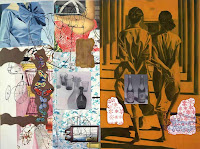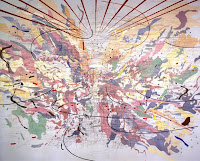I am currently reading The Doors of Perception by Aldous Huxley. This is my attempt to wrap my mind around some of his proposals.
His discourse about seeing and perceiving the universe is pertinent to all artists throughout history and the current day. He begins to describe the relationship with the object and its connection to infinity. Huxley argues that even renaissance painters of religious symbols and stories conveyed a sense of infinity within the folds of cloth worn by a saint or angel. The cloth not only describes the body but meanders in and out in space, coming and going freely as if a cloud. ¨In the average Madonna or apostle the strictly human, fully representational accounts for about ten percent of the whole¨ (Huxley 30). The other 90 percent of this religious icon is free to a sense of abstraction enacted by the artist. Not only is this an interesting idea in terms of artistic freedom in a time of strict religious patronage but also in the concept of the artist expressing godly creating when depicting ¨god¨.
Huxley compares his altered state of a mescalin trip to the artistic process ¨What the rest of us see only under the influence of mescalin, the artist is congenitally equipped to see all the time. His perception is not limited to what is biologically or socially useful...for the artist as for the mescalin taker draperies are living hieroglyphs that stand in some peculiarly expressive way for the unfathomable mystery of pure being¨(Huxley 33). In the classical tradition, creating draperies were an opportunity the abstract and express an inner perception of these folds. Opposed to the fixed patronage of the latter days, the contemporary artist does not necessarily choose her/his subject or concept (although art institutions still have a strong pull in determining subject matter) . The artist is simply a vessel to filter the tactile and visual human experience into something plastic and suggestive of this infinity.
The idea of the drapery or more generally the naturalistic form is suited for transfiguration. I think this is where my rotting banana/shrimp/fossils/turkey business is heading. I have been abstracting these forms into types of psychological landscapes that meld into their surroundings....




























